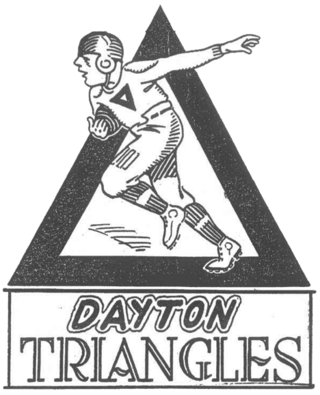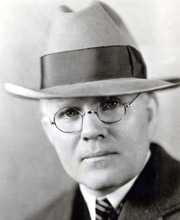Related Research Articles
The Columbus Panhandles were a professional American football team based in Columbus, Ohio. The club was founded in 1901 by workers at the Panhandle shops of the Pennsylvania Railroad. They were a part of the Ohio League from 1904 before folding after one season. Three years later, the team tried again, playing in the Ohio League from 1907 to 1919, not winning a championship, before becoming charter members of the American Professional Football Association (APFA) which became the National Football League (NFL).

The Dayton Triangles were an original franchise of the American Professional Football Association in 1920. The Triangles were based in Dayton, Ohio, and took their nickname from their home field, Triangle Park, which was located at the confluence of the Great Miami and Stillwater Rivers in north Dayton. They were the longest-lasting traveling team in the NFL (1920–1929), and the last such "road team" until the Dallas Texans in 1952, who, coincidentally, descended from the Dayton franchise.

Joseph Francis Carr was an American sports executive in football, baseball, and basketball. He is best known as the president of the National Football League from 1921 until 1939. He was also one of the founders and president of the American Basketball League (ABL) from 1925 to 1927. He was also the promotional director for Minor League Baseball's governing body from 1933 to 1939, leading an expansion of the minor leagues from 12 to 40 leagues operating in 279 cities with 4,200 players and attendance totaling 15,500,000.
The Ohio League was an informal and loose association of American football clubs active between 1902 and 1919 that competed for the Ohio Independent Championship (OIC). As the name implied, its teams were mostly based in Ohio. It is the direct predecessor to the modern National Football League (NFL).
The 1922 Columbus Panhandles season was their third in the league and last season as the Panhandles. The team failed to improve on their previous output of 1–8, losing all their games. They tied for fifteenth place in the league.
The 1921 Columbus Panhandles season was their second in the newly formed American Professional Football Association. The team failed to improve on their previous output of 2–6–2, winning only one league game. They finished seventeenth in the league.
The 1920 Columbus Panhandles season was the franchise's inaugural season in the American Professional Football Association (APFA)—later named the National Football League. The season concluded with the team going 2–6–2 and finishing 13th place in the APFA standings. The Panhandles entered the season after a 3–6–1 record in 1919. The team opened the 1920 season with a loss to the Dayton Triangles, and the Panhandles lost five straight until a victory over the Zanesville Mark Grays. Not a single player was on the All-Pro list.

The Nesser brothers were a group of American football-playing brothers who helped make up the most famous football family in the United States from 1907 until the mid-1920s. The group consisted of seven brothers who worked for Panhandle Division of the Pennsylvania Railroad in Columbus, Ohio, and who were later used as the foundation for the Columbus Panhandles of the Ohio League, and later the National Football League, when the club was founded by future NFL president Joe Carr in 1907.
The 1916 Columbus Panhandles season was their 11th season in existence. The team played in the Ohio League and posted a 7-5-0 record.
The 1913 Columbus Panhandles season was their eighth season in existence. The team played in the Ohio League and posted a 3-4-2 record.
The 1914 Columbus Panhandles season was their ninth season in existence. The team played in the Ohio League and posted a 7–2 record.
The 1915 Columbus Panhandles season was their tenth season in existence. The team played in the Ohio League and posted an 8–3–1 record.
The 1919 Columbus Panhandles season was their 14th season in existence. It was also the last time that the team played in the Ohio League, before joining the early National Football League the following year. The team posted a 3-6-1 record.
The 1917 Columbus Panhandles season was their 12th season in existence. The team played in the Ohio League posted a 3–6 record.
The 1910 season was the fifth season of the Columbus Panhandles. The team played in the Ohio League posted a 3–2–2 record.
The 1911 Columbus Panhandles season was an American football team played professional football in the Ohio League. The team compiled a 7–2–1 record and played its home games at Indianola Park in Columbus, Ohio.
Herbert Edward Dell was an American football official and coach. He served as the coach of the Columbus Panhandles in the 1922 season, compiling a record of 0–8.
The Zanesville Mark Grays were an Ohio League and Independent football team that existed for seven seasons. They played in 4 Ohio League seasons.
The Columbus Wagner Pirates were an American football team that played seven seasons; from 1920 to 1926. They played in one APFA game in 1920.
Harold Matthew Gaulke was an American football player. He played professional football for the Columbus Panhandles in 1917 and from 1919 to 1922. He was the Panhandles’ starting quarterback in the first official National Football League game in October 1920.